This Smoking Wood Chart takes all the guessing out of what wood pairs perfectly with different foods, including seafood and vegetables.
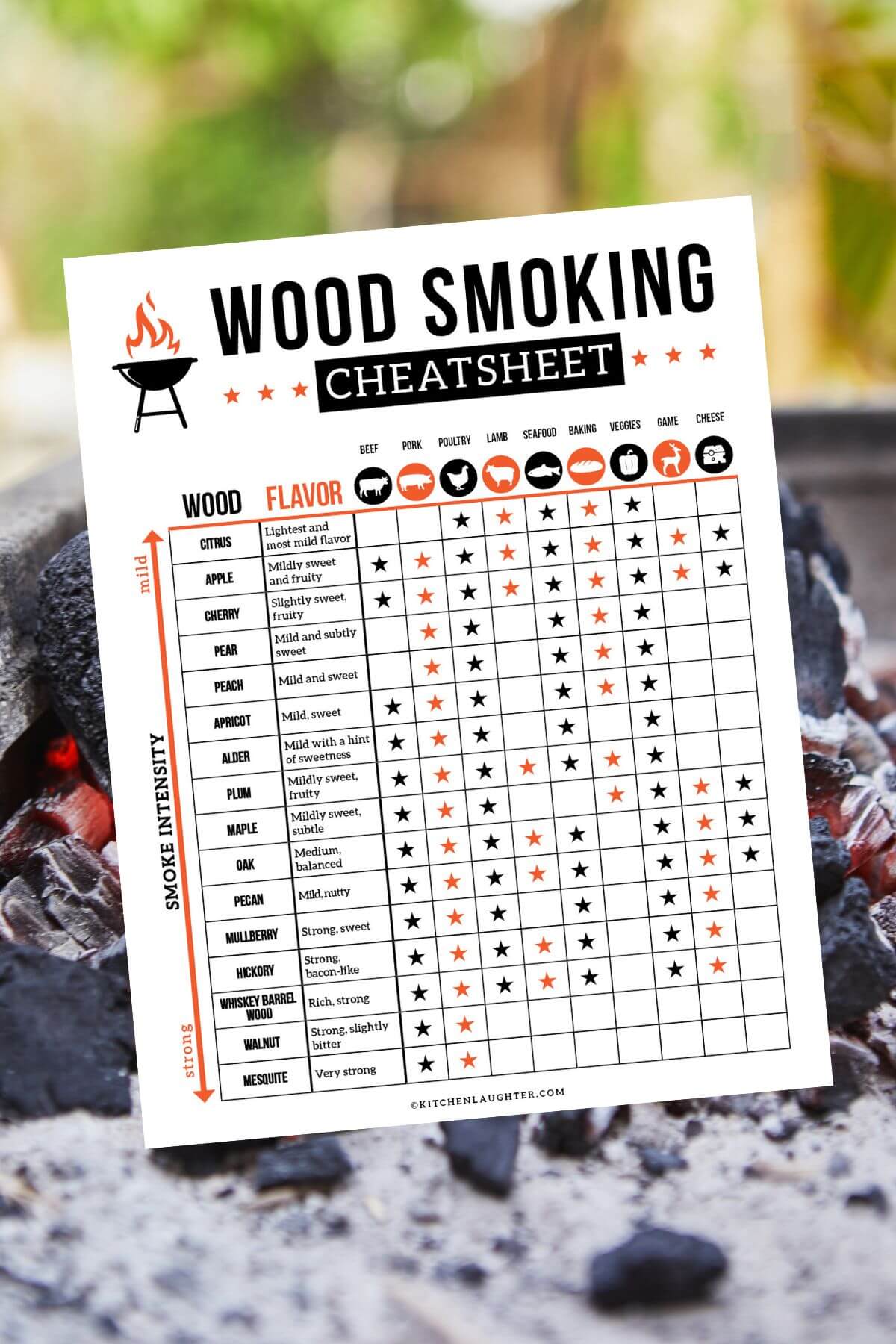
It’s not always easy to know which kind of wood to smoke with each package of meat I plan to put on the grill. Does peach wood go well with beef? Will hickory work with chicken? The answers are all there for you on a single-page PDF.
🍁 Why This Works
Easy To Use – As soon as the ink dries, your handy smoking wood cheat sheet is ready for use!
Quick Reference Tool – This one-sheet PDF can be printed off and hung in the pantry or you can add a magnetic sheet to the back of it for quick and easy reference on the side of the refrigerator.
🔥 How it Works
Step 1: Look at the left-hand side of the page first as it will guide you through the MILD to STRONG intensity scale. This is the area that I call attention to first and will be the most important. Each piece of wood that you choose to smoke with gives off a different intensity of smoke that will flavor the meat.
Step 2: Look at the types of wood and the flavor columns. If you haven’t used wood to smoke, then I recommend starting out with the milder smoke flavors. The more intense flavors can overpower a dish if you’re not careful.
Step 3: Pair up the type of food you will be smoking with one of the complementary woods.
✔️Overview of Best Wood for Smoking
| Smoke Intensity | Wood | Flavor | Beef | Pork | Poultry | Lamb | Seafood | Baking | Veggies | Game | Cheese |
|---|---|---|---|---|---|---|---|---|---|---|---|
| Mildest | Citrus | Lightest and most mild flavor | X | X | X | X | X | ||||
| Apple | Mildly sweet and fruity | X | X | X | X | X | X | X | X | X | |
| Cherry | Slightly sweet, fruity | X | X | X | X | X | X | X | X | X | |
| Pear | Mild and subtly sweet | X | X | X | X | X | |||||
| Peach | Mild and sweet | X | X | X | X | X | |||||
| Apricot | Mild, sweet | X | X | X | X | X | X | ||||
| Alder | Mild with a hint of sweetness | X | X | X | X | X | |||||
| Plum | Mildly sweet, fruity | X | X | X | X | X | X | X | |||
| Maple | Mildly sweet, subtle | X | X | X | X | X | X | X | |||
| Oak | Medium, balanced | X | X | X | X | X | X | X | X | ||
| Pecan | Mild, nutty | X | X | X | X | X | X | X | X | ||
| Mulberry | Strong, sweet | X | X | X | X | X | X | ||||
| Hickory | Strong, bacon-like | X | X | X | X | X | X | X | |||
| Whiskey Barrel Wood Chips | Rich, strong | X | X | X | X | X | X | X | |||
| Walnut | Strong, slightly bitter | X | X | ||||||||
| Strongest | Mesquite | Very strong | X | X |
📝Free Printable Smoking Wood Chart
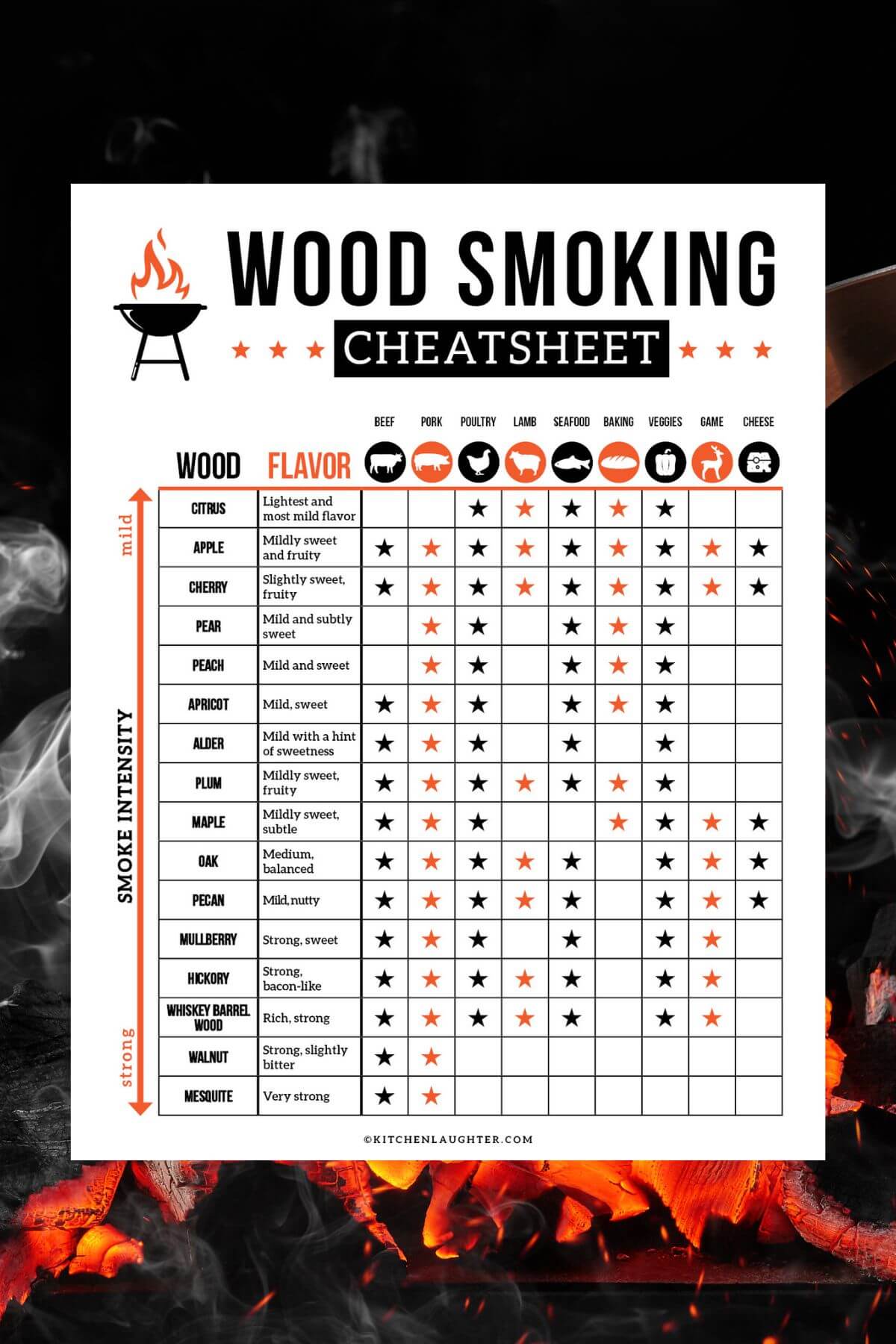
This is a simple smoking wood cheat sheet you can print at home on regular U.S. Letter paper (8.5″x11″).
We organized smoking woods by flavor intensity so you can quickly make a choice based on how strong you’d like the smoke flavor to be.
Citrus
Orange, lemon, grapefruit, and other citrus woods pair well with seafood, poultry, lamb meat, baked goods, and veggies. They have a very light smoky flavor accompanied by subtle citrus notes. This is perfect as the smoke won’t overpower the delicate flavors of these foods.
Try it for smoked tuna steaks, smoked cauliflower, smoked whole trout, and smoked asparagus bundles.
Best for: poultry, seafood, lamb, vegetables, baked goods.
Apple
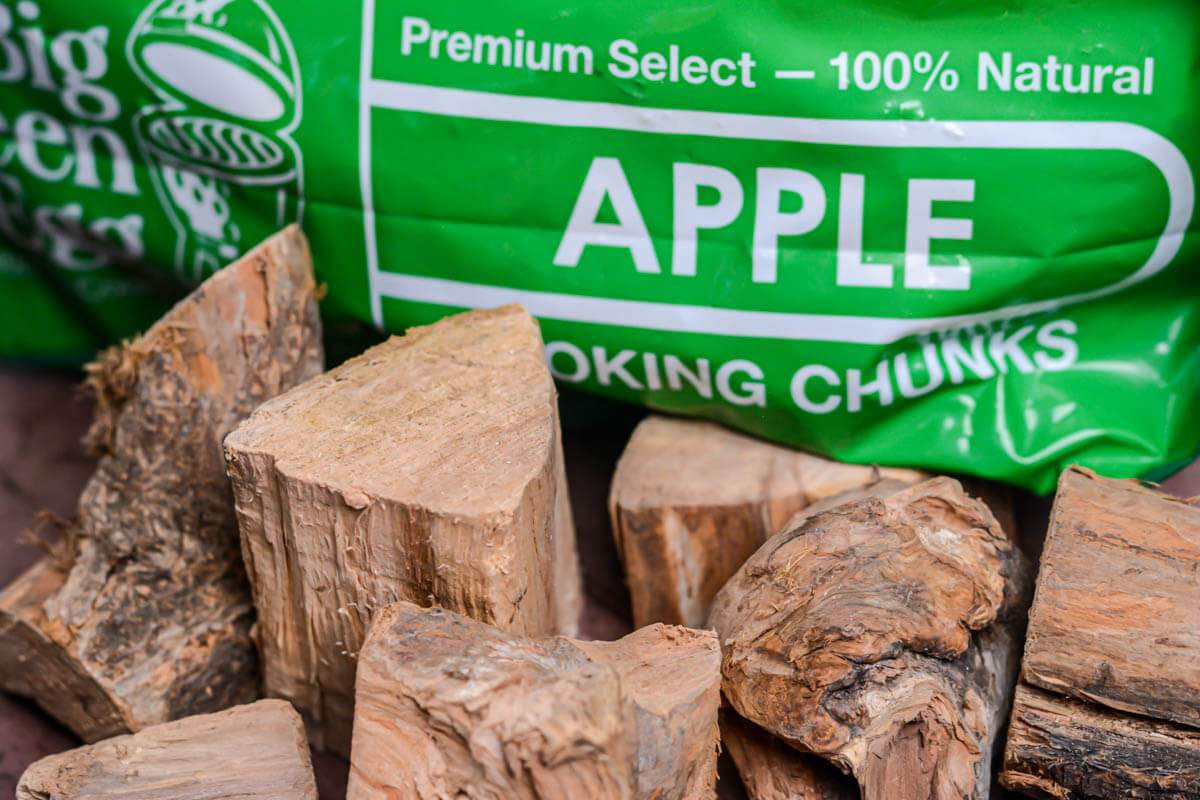
This wood imparts a mild, fruity smoke suitable for poultry, beef, pork, veggies, lamb, seafood, and baked goods.
We love using apple wood for a variety of recipes and it’s a top choice on my list of best wood for smoking chicken.
It’s always good to have some apple wood for all the times when you don’t want a bold smoke flavor as it goes well with pretty much anything.
We love it for smoked butternut squash, smoked chuck roast, smoked beef tenderloin, smoked eggs, and smoked whole chicken.
Best for: beef, pork, poultry, lamb, seafood, baking, vegetables, cheese, and game.
Cherry
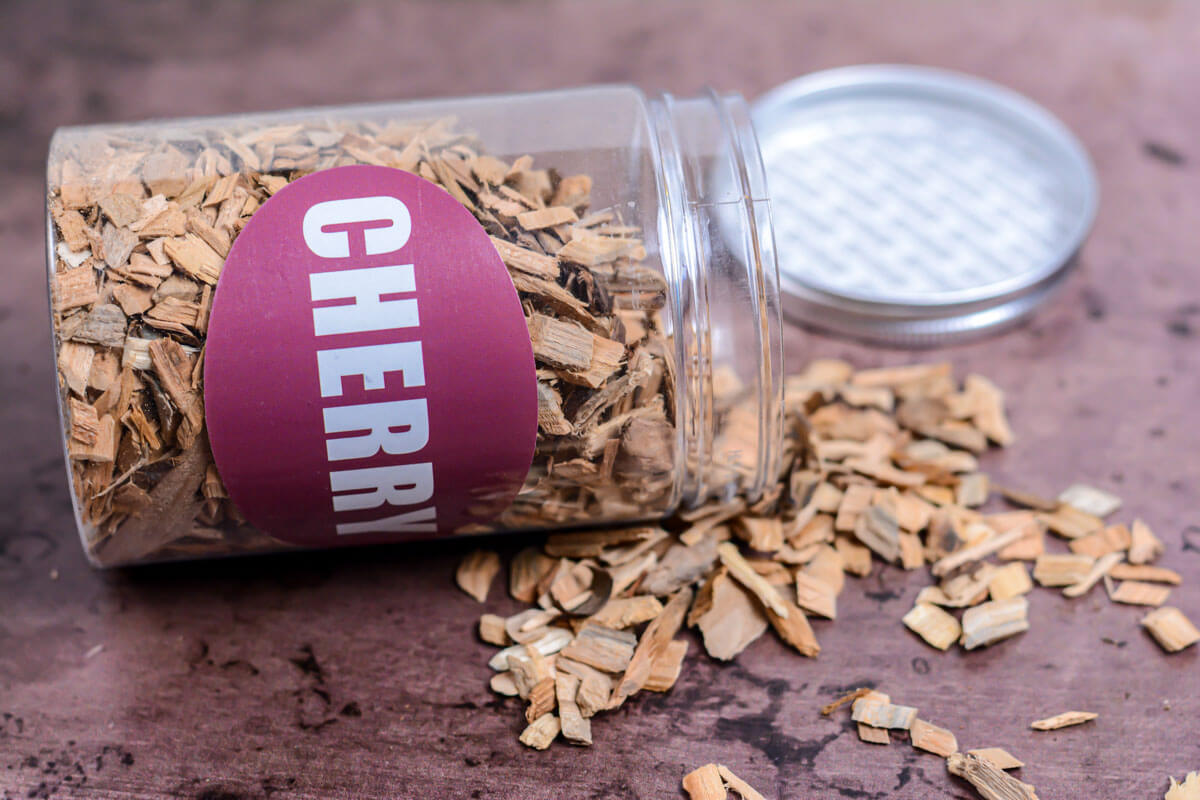
As one of the most popular smoking woods, cherry wood complements any kind of meat: beef, pork, poultry, lamb, game, fish, and seafood. It adds a sweet flavor and a crowd-pleasing mild smoke so you can’t go wrong with this choice.
Because it adds a lovely reddish hue to smoked meat, I always use it when making twice-smoked ham.
It’s also great for enhancing the natural flavors of smoked turkey thighs, smoked chicken wings, and smoked Tomahawk pork chops.
I’m sure you’ll love it on smoked appetizers such as smoked cream cheese, and smoked pretzels. Just make sure you smoke enough because these won’t last long!
Best for: beef, pork, poultry, lamb, game, baking, veggies, cheese, and seafood.
Pear
Light and sweet like apple, pear wood is an excellent choice for infusing pork, poultry, fish, seafood, vegetables, and baked goods.
We use it often for smoking poultry as it doesn’t overpower other flavors coming from BBQ rubs, marinades, and brines. Try it for smoked spatchcock chicken, and pulled smoked chicken, or go for a faster recipe such as smoked chicken quarters. Paired with this simple all-purpose BBQ dry rub, it’s a match made in heaven!
Best for: pork, poultry, vegetables, seafood, and baked goods.
Peach
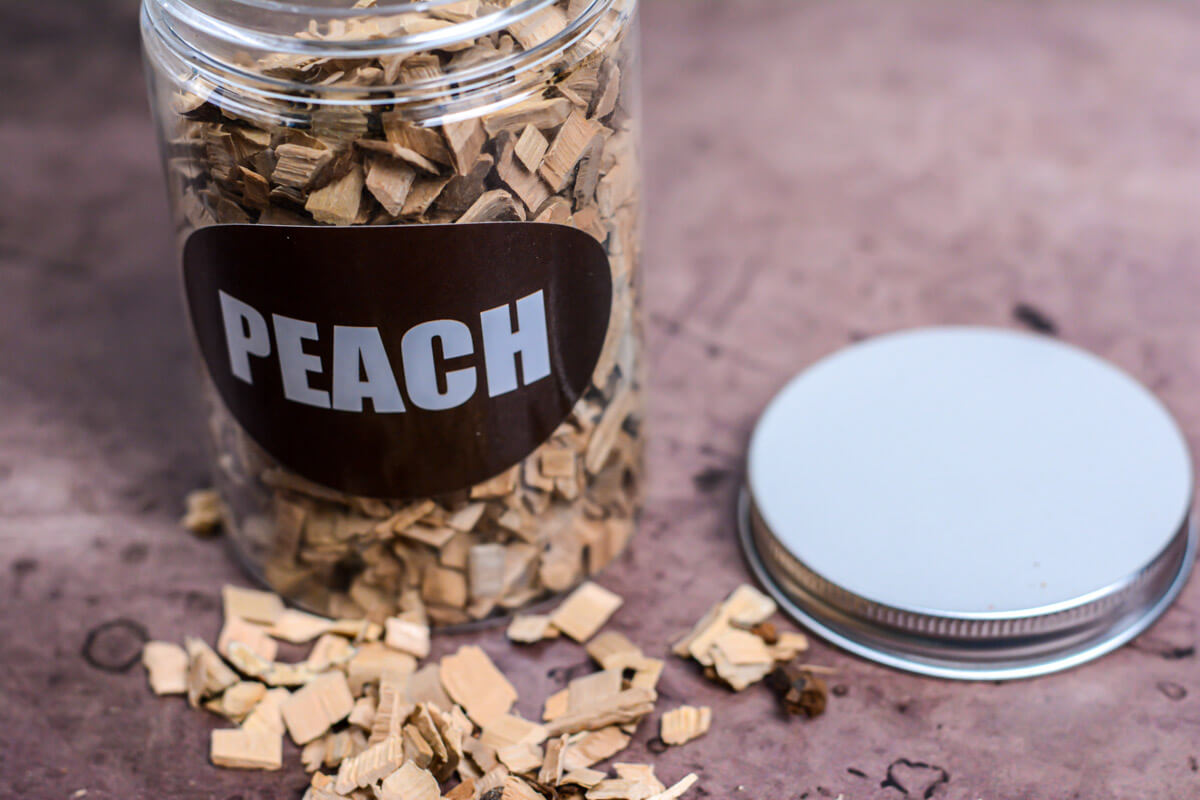
Pork, poultry, seafood, and baked goods will get a lovely smoke flavor from this mild smoking wood.
Peach wood is perfect for meats that are already flavorful because it won’t overpower them. I loved it for smoked goose breast pastrami, and it’s also a good choice for small game birds, such as smoked quail.
While this is not my primary recommendation for smoked vegetables, I think it works well for smoked corn on the cob, and mild smoked appetizers like this smoked queso dip.
Best for: pork, poultry, seafood, veggies, and baked goods.
Apricot
Craving a touch of sweetness in your smoke? Apricot wood will not disappoint. It’s a prime pick for when you’re smoking beef, imparting a mild, sweet flavor that truly complements the robustness of the meat.
And for pork lovers, apricot wood adds that perfect hint of fruity sweetness that pork so beautifully absorbs.
Poultry also gets a delightful twist with apricot wood. It’s subtle enough not to mask the delicate flavors of chicken, yet distinctive enough to make a memorable meal.
Venturing into baked goods? Apricot wood’s sweet notes can turn ordinary baked treats into extraordinary smoked delights.
Best for: beef, pork, poultry, seafood, baking, and veggies.
Alder
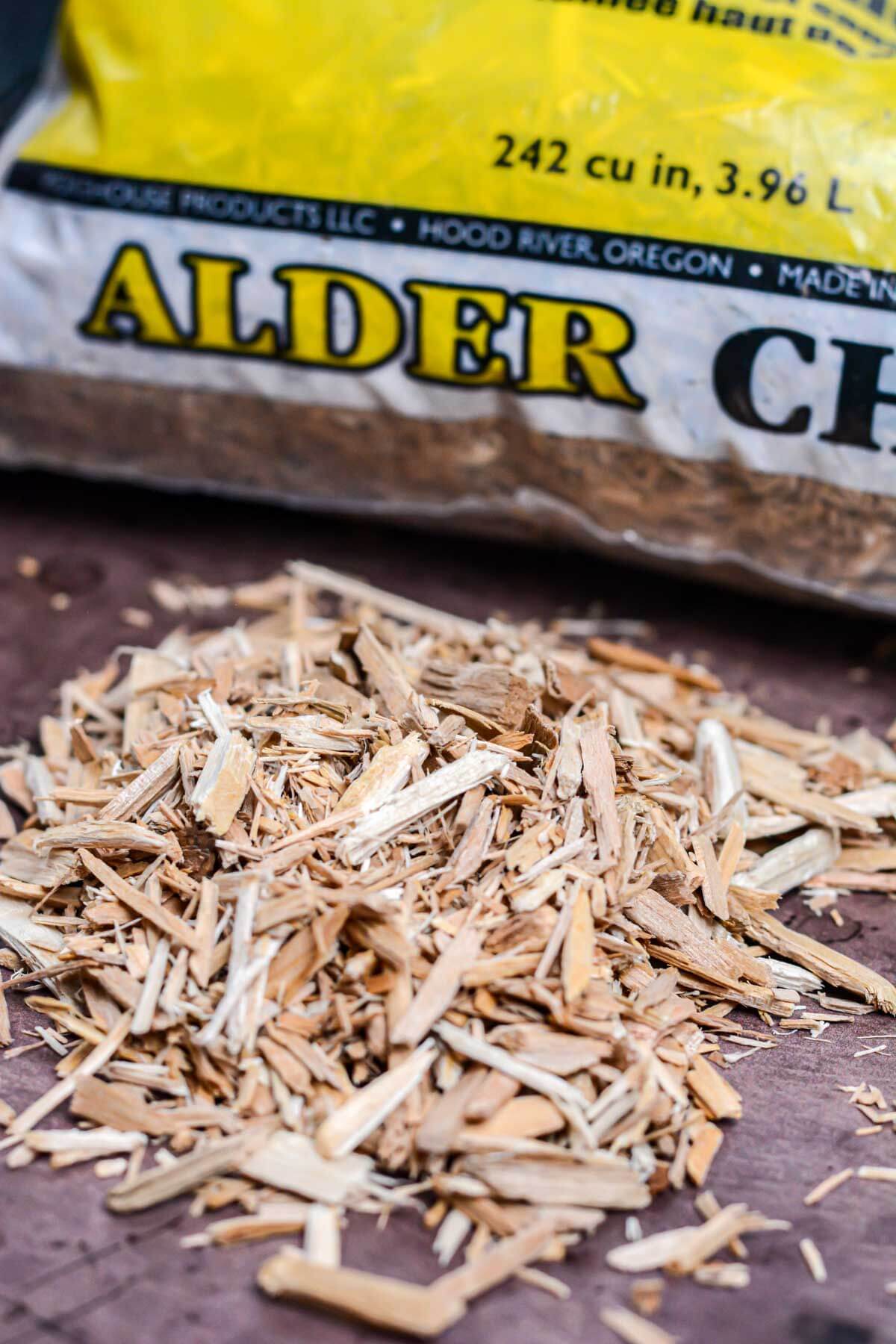
As one of the lightest hardwoods, we love alder for smoking fish and seafood thanks to the balanced flavor it provides but its versatile aroma can also complement beef, pork, poultry, and vegetables.
If you’re a beginner, I recommend trying it for smoked salmon, and smoked Pacific rockfish. Also, feel free to experiment with other types of fish and seafood. I’m sure they’ll all turn out delicious!
Best for: beef, pork, poultry, seafood, and veggies.
Plum
For many people hickory’s flavor can be too intense. Plum wood has a similar flavor but milder, which makes it a great substitute. Compared to most smoking woods, it’s not as easily available, but its place on our smoking wood chart is well deserved.
You can use plum wood to smoke all kinds of meat, including pork, beef, poultry, and lamb.
I recommend you try it first for a faster recipe, like this smoked bacon-wrapped pork tenderloin since the reduced cooking time means it’s less likely to infuse the meat with too much smoke flavor.
Best for: beef, pork, poultry, lamb, seafood, and veggies.
Maple
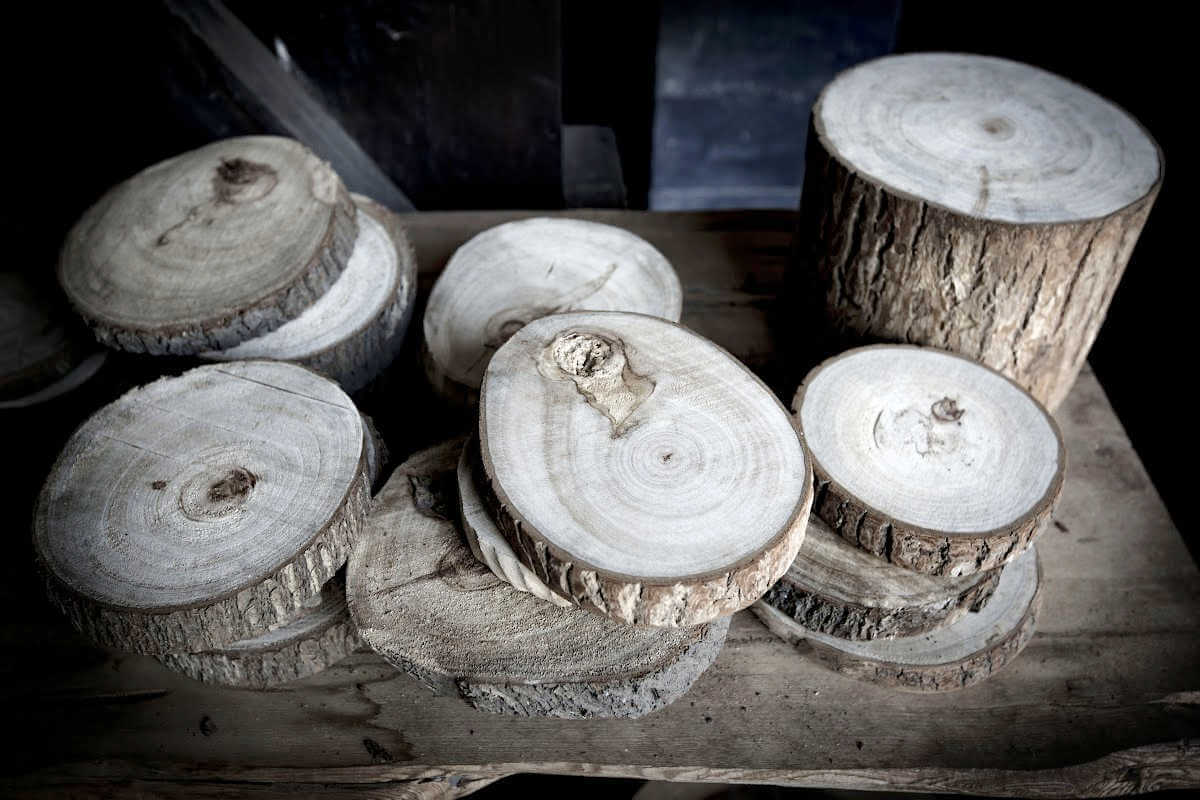
One of the best woods for smoking salmon and a good option for those looking for a balanced smoke aroma.
Its flavor is slightly sweet like maple syrup, making it great for smoking veggies, beef, pork, and poultry.
There are endless ways to use it but if you’re looking to start simple, try it for these smoked baked potatoes. Who can say no to that?
Cheese is another food that can be smoked with maple wood. It needs a reduced smoking time, so it makes sense to use a more potent smoking wood like maple. Make some smoked baked Brie for your next BBQ cookout and I promise you’ll get raving reviews!
Chicken meat turns out fantastic when smoked with maple. Whether you want a whole smoked beer can chicken or you’re going for smaller cuts, it will give a wonderful medium smoke.
Best for: beef, pork, poultry, baked goods, vegetables, game, and cheese.
Oak
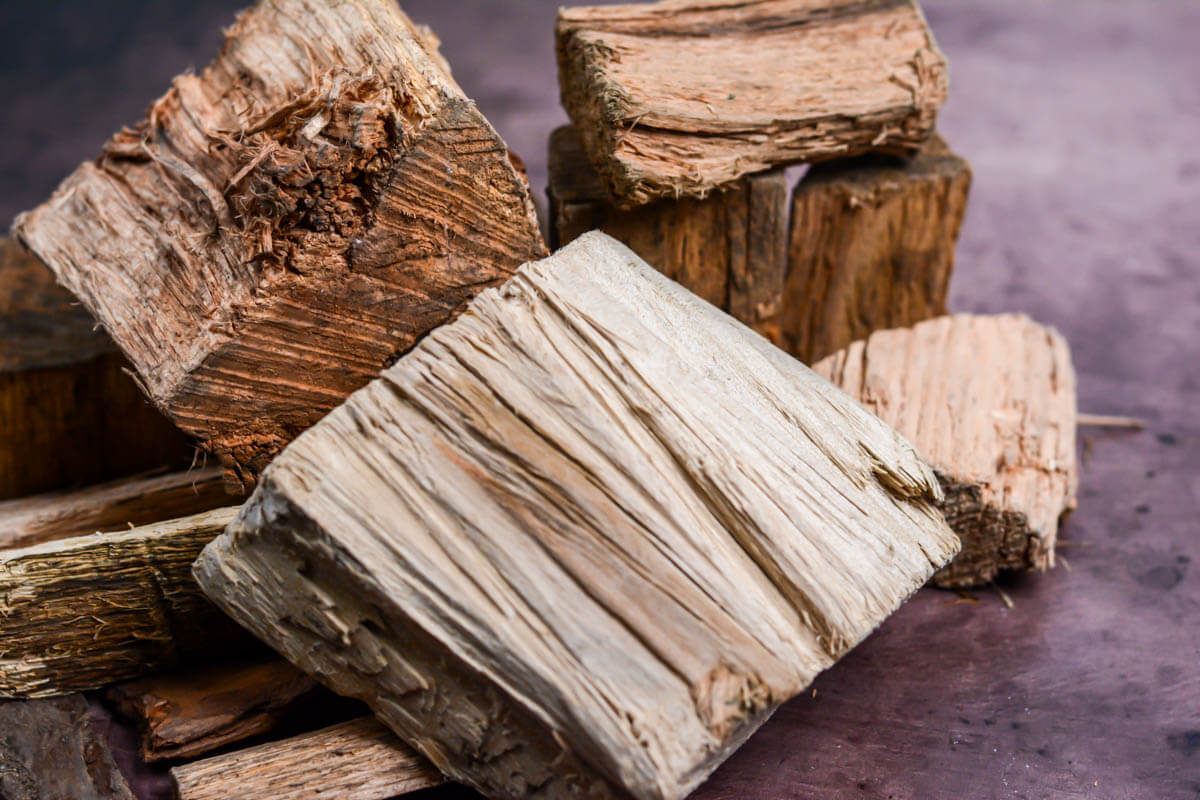
Looking for a classic medium smoke? Oakwood will give you that!
It will also add a rich, brownish color to smoked meats and I definitely recommend having it in your arsenal. Its earthy flavor pairs well with poultry, beef, pork, and lamb.
Oak is one of the best woods for smoking ribs, as the medium-smoke will make the meaty bones finger-licking good!
My top choice for smoked brisket is hickory, but I recommend choosing oak if you’re not a fan of intense smoke flavors.
Furthermore, oak wood works well for quick smoker recipes like smoked hot dogs, and medium-thick beef cuts like smoked top round roast.
Best for: beef, pork, poultry, lamb, seafood, veggies, game, and cheese.
Pecan
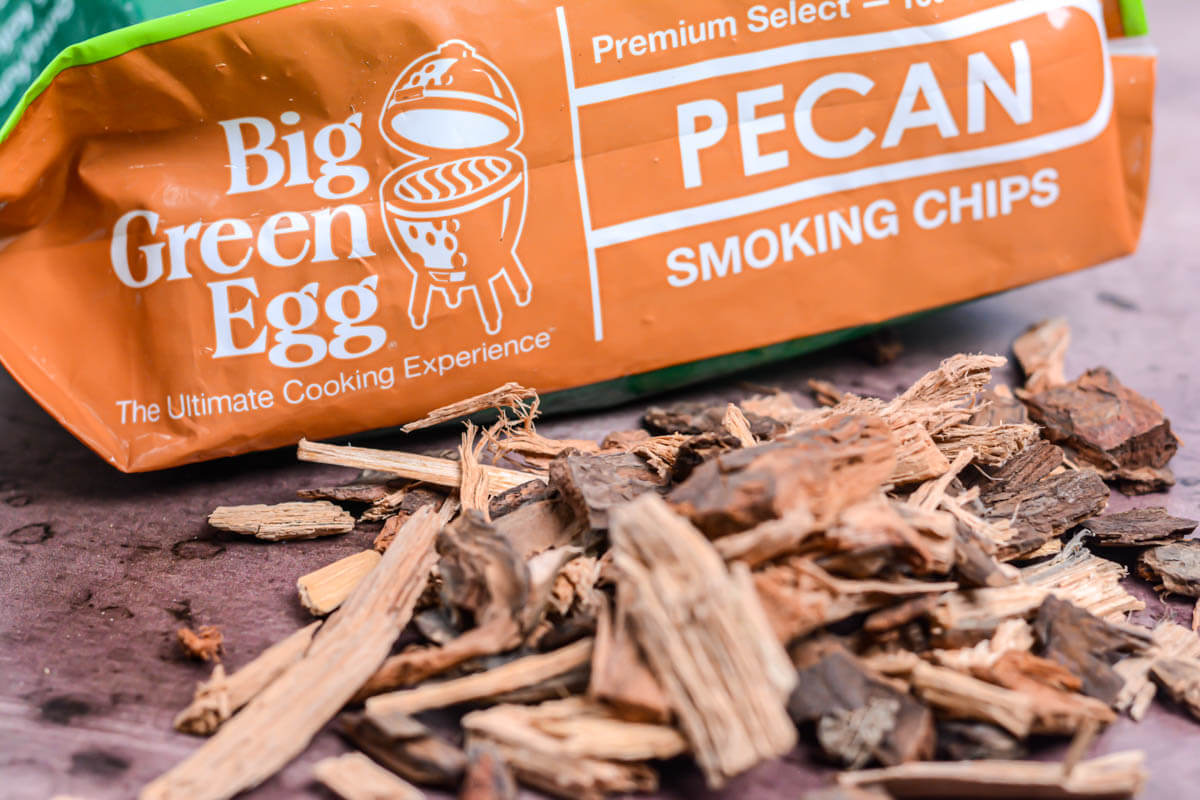
Just like hickory, pecan wood should be used in small quantities. It burns fast and produces lots of smoke so it’s not an ideal choice for meat cuts that require low and slow cooking such as smoked pork roast.
However, its sweet smoke flavor has a specific nuttiness and spiciness that BBQ aficionados greatly appreciate. Use it for any pork or poultry meat and feel free to mix it with milder woods such as apple or peach to tone it down.
You can also try pecan in reasonable quantities or mixed with lighter wood for smoking lamb, seafood, baked goods, and vegetables.
I found that the natural woodsy flavor of pecan makes it one of the best woods for smoking turkey, and the same applies to chicken and other types of poultry, including small game birds such as smoked quail.
If this is your first time smoking with pecan wood, choose a recipe with a shorter smoking time to avoid any mishaps. While not a traditional recommendation, pecan can also pair well with smaller beef cuts because they don’t get to spend too much time in the smoker.
It worked great for us when making smoked hamburgers, smoked flank steak, poor man’s burnt ends, smoked turkey wings, smoked chicken breast, and smoked chicken thighs.
Best for: beef, pork, poultry, lamb, seafood, vegetables, and baking.
Mulberry
Mulberry wood is a less common but impressive choice for smoking, offering a strong, sweet smoke that’s particularly well-suited to a variety of meats and other foods.
Its robust flavor pairs splendidly with beef, enhancing the meat’s natural richness. Pork and poultry also benefit from Mulberry’s sweet smoke, which complements these meats without overpowering them.
When it comes to seafood, Mulberry wood adds an unexpectedly delightful twist, and its sweet notes are a match made in heaven for smoked veggies and game meats. Even cheese takes on a deliciously unique flavor when smoked with Mulberry wood.
Best for: beef, pork, poultry, seafood, veggies, game, and cheese.
Hickory
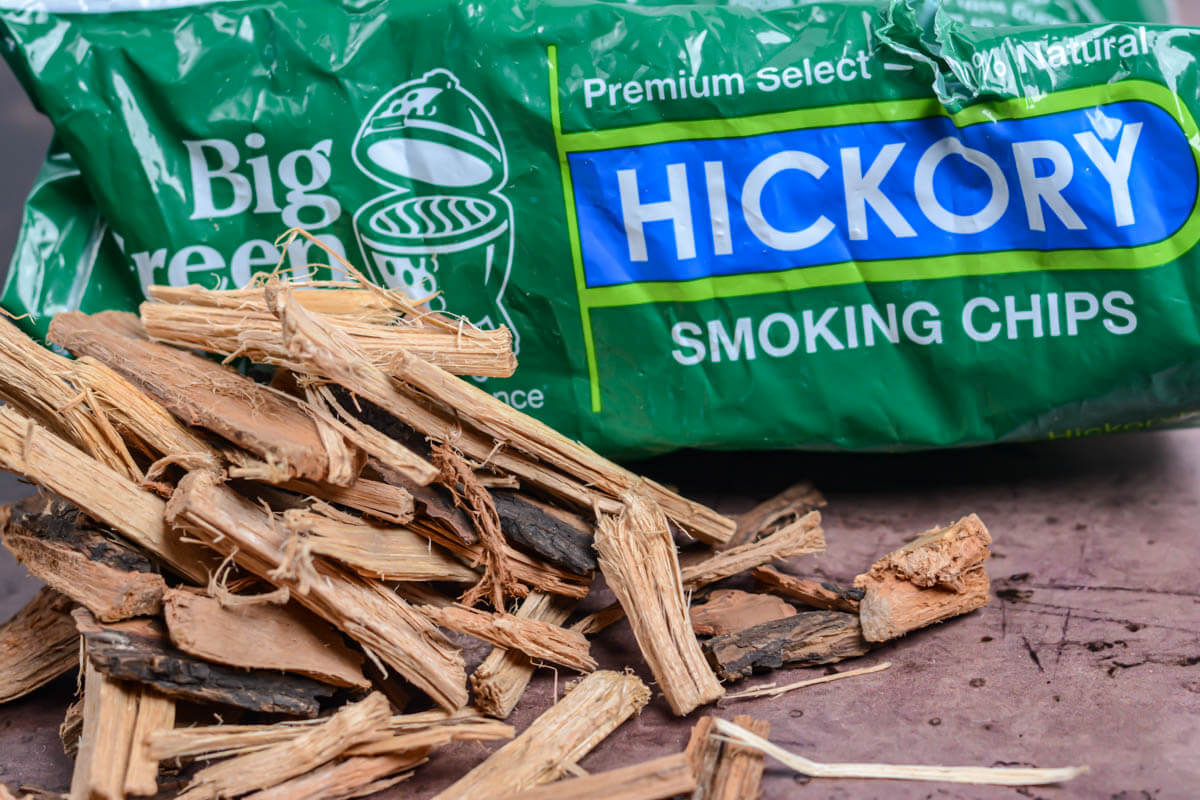
Fans of the bold smoke flavor will absolutely love what hickory can do as a smoking wood, especially for red meat. As a beginner, I recommend you consult the smoking wood chart for milder options or mix hickory with a fruitwood to tone it down.
Hickory adds a rich, bacon-like, earthy bouquet and it’s best used sparingly. If you add too much of this wood to the smoker it can make food bitter, so be careful!
With all precautions in place, you can’t go wrong with using it for smoked chuck roast, and it’s definitely one of the best woods for smoking brisket.
Best for: beef, pork, poultry, lamb, seafood, game, and veggies.
Whiskey Barrel Wood Chips
Whiskey Barrel Wood Chips are a specialty smoking wood derived from aged whiskey barrels, offering a rich, strong flavor that infuses smoked dishes with the essence of fine spirits.
This unique wood type, with its deep, robust notes, is fantastic for beef, imparting a hearty smokiness that elevates the meat’s natural savoriness.
Pork and poultry also take on a delectable richness when smoked with these wood chips, while lamb is transformed with a complex, layered taste.
Seafood gains an unmatched smoky depth, and even vegetables and game meats are enhanced with a distinctive flavor that only whiskey-infused wood can provide.
You can even use these wood chips to add flavor to other foods like we did for this Bourbon barrel smoked cranberry sauce. We used Bourbon barrel wood chips which have a spirit-infused smoky flavor similar to Whiskey barrel wood chips.
Best for: beef, pork, poultry, lamb, seafood, veggies, and game.
Walnut
On its own, walnut wood delivers one of the most intense and bitter smoke flavors and thus should only be used on red meats such as beef, pork, and game. Both walnut and pecan are nut woods, but the first is more potent.
Unless you mix it with milder smoking wood like apple or peach, walnut is not a good choice for light-colored meats like poultry and seafood.
In combination with lighter-flavored wood, you can definitely use it for chicken and turkey. Just a little goes a long way for a smoked Spatchcock turkey. Or try it for a smoked pheasant when you want to make a special meal.
Best for: beef and pork.
Mesquite
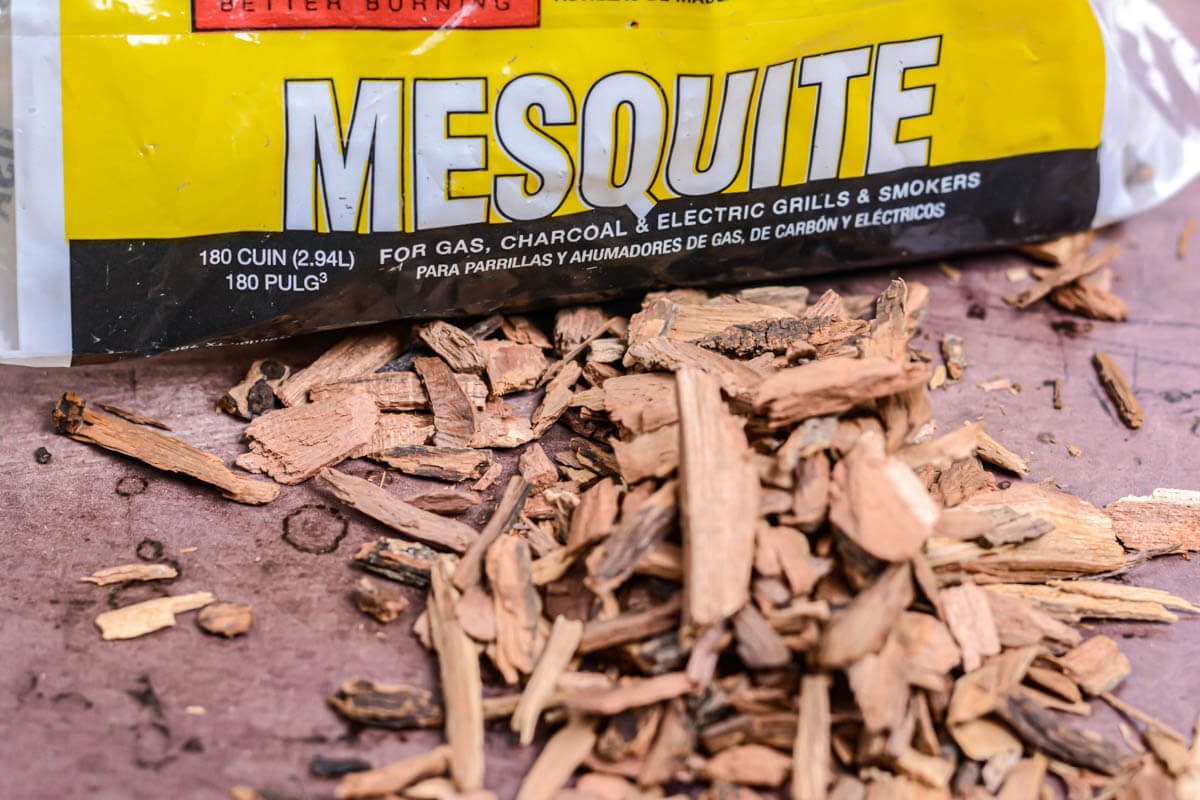
This is one of the most popular woods in Texas BBQ culture, most often paired with beef, although not easy to cook with. Mesquite has a very strong smoke flavor and will give smoked meat a darker reddish shade.
Because of the sharp aroma, it can easily overpower the meat and is best used in combination with hickory, oak, or milder woods.
This is the way I use it for longer smokes such as brisket. The flavor profile is intense but not overwhelming. It amps up leftover brisket recipes such as brisket grilled cheese, and smoked brisket and beer queso.
On its own, we prefer it for recipes with a short smoking time, like these smoked St. Louis Style ribs. Even so, we use a small amount.
Mesquite burns slowly and evenly which means in most cases, you don’t need to add another batch of chips or chunks into the smoker.
Best for: beef and pork.
Note: These are my personal recommendations. If you have tried pairings that are not listed, and you loved it, then drop me a note below. I love to try new things and am interested in what you found success with.
⛔What Woods Are Bad For Smoking?
Cypress, pine, spruce, sycamore, redwood, eucalyptus, elm, fir, yew, and oleander are all terpene-rich softwoods that are not suitable for use as smoking woods.
Cedar is another resinous softwood rich in sap that can impart an unpleasant taste and smell when used for smoking. It does work well for adding flavor in other ways. Grilled crusted salmon on a cedar plank was fantastic. The same method can be used for other types of fish like grilled cedar plank Chilean sea bass.
Poison walnut is another type of wood that’s not suitable for smoking food. It’s a type of hardwood but unlike regular walnut, it will infuse the meat with toxic substances that are not safe for ingestion.
Sassafras is not good for smoking either: this hardwood contains safrole, a toxic chemical not fit for human consumption.
Other Types Of Wood You Should Not Smoke With
As tempting as it might be to use it, avoid moldy wood when smoking. Some mold varieties can release toxins so it’s not worth the risk.
Painted or treated wood like paneling, lumber scraps, plywood, or old pallets is also on the blacklist. Paint and wood treatments contain various chemicals that can cause serious illness when ingested or inhaled.
♨️Different Sizes Of Smoking Wood And How To Use Them
There are many variables that go into smoking food and the size of the wood is one of them. Deciding which is the best, depends on the type of smoker you are using, and the total smoking time.
Logs
These are ideal for stick burners and other types of offset smokers. Generally, they are both the heat and smoke source, so which type of wood logs you choose will be very important.
The logs are allowed to burn until they transform into embers before the cooking process is started. For this type of wood, a smoking temperature of 275°F is ideal, as lower temperatures might lead to incomplete combustion and unclean smoke.
Keep in mind that logs are not easy to smoke with. Maintaining a steady temperature is a challenge reserved for those who are already experienced pit masters.
Chunks
Wood chunks are smaller than logs, and their size varies. Chunks can be as small as a golf ball and up to 4 inches.
They are always used as a smoke source, placed on top of the charcoal. For large cuts such as brisket and pork shoulder that require low and slow cooking, wood chunks are an ideal choice.
Thanks to the consistent smoke and slow, even burning, you simply add them at the start of the smoking session with no need to keep opening the smoker for refills.
Chips
Wood chips are about the size of a coin and we love them for shorter smokes. They burn faster than chunks and you might need to add more during the smoking process. This is the usual choice for adding flavor when smoking in electric and gas grills and smokers.
My general guideline is to use them for anything that can be smoked in under 4 hours. For longer smokes, I recommend you go for wood chunks as they burn more slowly.
Sawdust
Sawdust is untreated wood ground into a coarse powder and as you can imagine, it will burn very quickly.
This is definitely not the kind of material to be used as a heat source but it works great for fast-cooked foods on portable smokers.
Pellets
Pellets are small cylinders made from compressed hardwood sawdust. They burn hot, clean, and produce minimal ash.
You can use wood pellets in pizza ovens and pellet smokers as a fuel source or flavor enhancers. The array of flavor choices for pellets is impressive so feel free to experiment!
‼️ Expert Tips
If you are new to smoking and aren’t sure what you like, begin with light and easy. Go for the fruit woods and see what you like before hitting hard and heavy on the hickory and mesquite.
For anyone who is super nervous about starting to smoke, I suggest doing a faux smoke. Grill your favorite dish without any smoke to serve as the baseline for comparison. Now, add a few chunks of a mild wood for your next batch and take notes on how you and your family liked it.
For this example, I smoked a prime rib roast for my mother-in-law who doesn’t love too much smoke. I grilled it low and slow for over 9 hours at 225°F but there wasn’t any wood in my Big Green Egg, just charcoal. The taste was fantastic and not smoky at all, yet it was the most tender cut of meat she ever had.
We enjoy a light smoke flavor so we used a nice cherry wood for the first few hours when we grilled our next rib roast.
Important: Know that leftovers that are not meat-based seem to have the smoky flavor intensify the longer it is kept in the refrigerator. We’ve noticed that our leftover meat tasted about the same, but our leftover Smoked Deviled Eggs and Smoked Potato Salad had the smoke flavor intensify significantly the second day.

Lesser Known Smoking Wood
Sometimes you will come across less common smoking wood that is not on our free printable smoking wood chart, like when we made the Bourbon Barrel Cranberry Sauce using wood from an oak bourbon barrel.
Oak is considered a classic/medium smoke so we matched it with the cranberry sauce as it wasn’t smoking very long and it turned out fantastic.
Beech is another less common smoking wood with a mild, nutty flavor that’s preferred for smoking poultry and cheese.
Washed and dried seaweed is a flavor enhancer used for smoking shellfish such as lobster, crab, shrimp, clams, and mussels. So many options to try, right?
🖨️How to Grab
I would love to give you this smoking wood chart printable for FREE. Please add your email address to the form below, and I will send it to you immediately!
❓F.A.Q.
The ideal choice of smoking wood definitely depends on your personal taste, but in terms of versatility apple, cherry, and oak, are always good to have on hand.
Opt for fruitwood such as apple, cherry, citrus, or peach if you want a subtle smoke flavor infused into your food. Alder is also a good choice especially for poultry and seafood, as one of the mildest flavored hardwoods.
Wood scraps, whether painted, stained, or pressure treated are not safe for cooking as they can contain arsenic, and other dangerous chemicals which can make you sick if you ingest or inhale them.

Jason’s been firing up the grill for over 30 years after graduating from the US Coast Guard Academy. His love of finely-grilled steak and chicken led him to buy his first Weber grill to put on his apartment patio in 1992. Each military move led to a new grill (a mixture of gas and charcoal) until he fell in love with the Big Green Egg in 2008. Since then, he has added another 4 grills to the collection. Yes, he has a problem. Jason loves smoking in the ceramic BGE with exotic woods including olive wood from Egypt and hard to find varieties such as sassafras and orange wood. Jason takes the term “foodie” to a whole new level, jumping at the chance to take food tours and cooking classes during foreign travels. These have provided inspiration to incorporate new ideas into recipes when he gets back home. He has been featured in Fox News, Parade, Yahoo News, Kansas City Living and more. After retiring from the military and moving to southwest Florida, he has focused grilling and smoking locally sourced meats and fish (read: he likes to catch his own fish!)
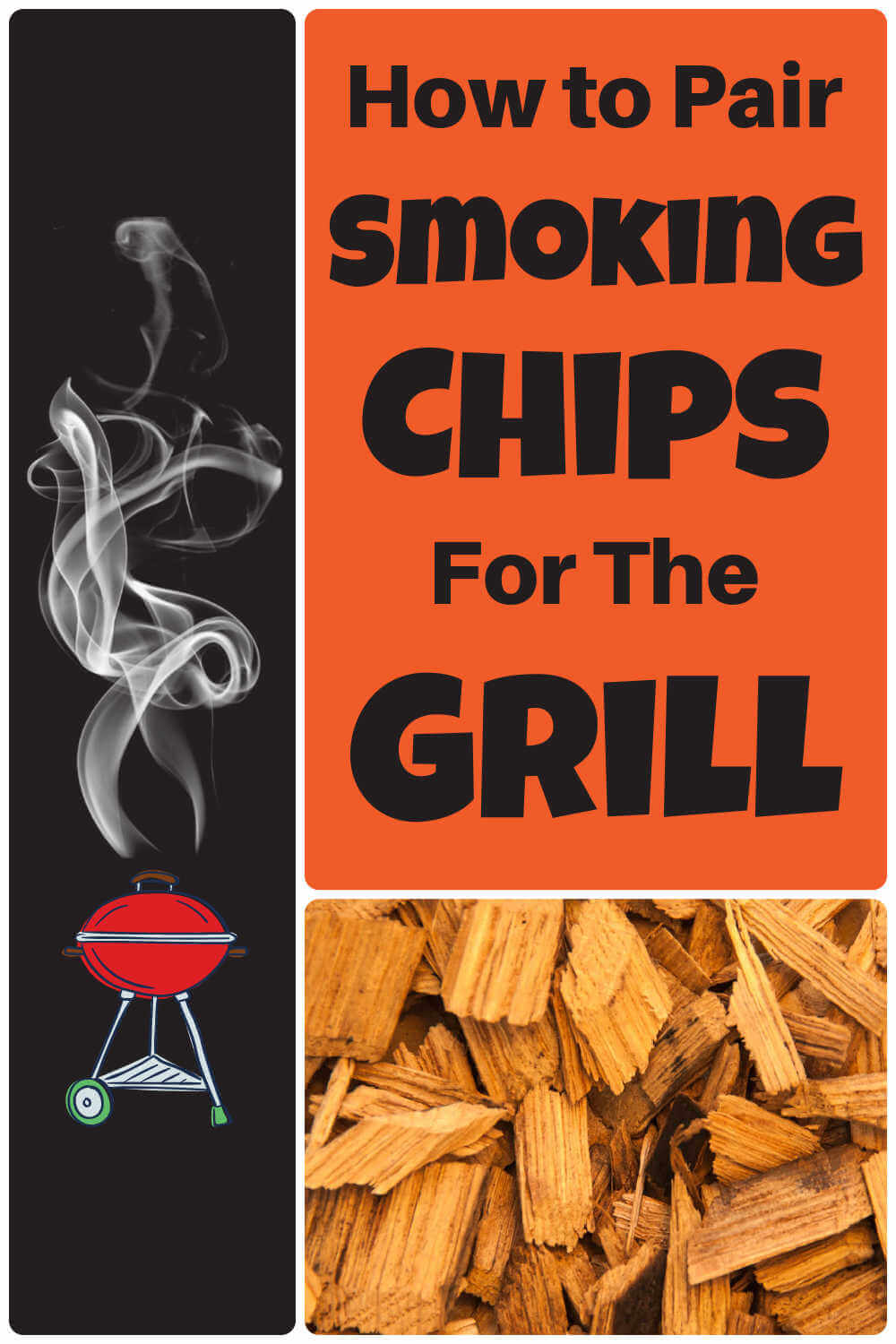
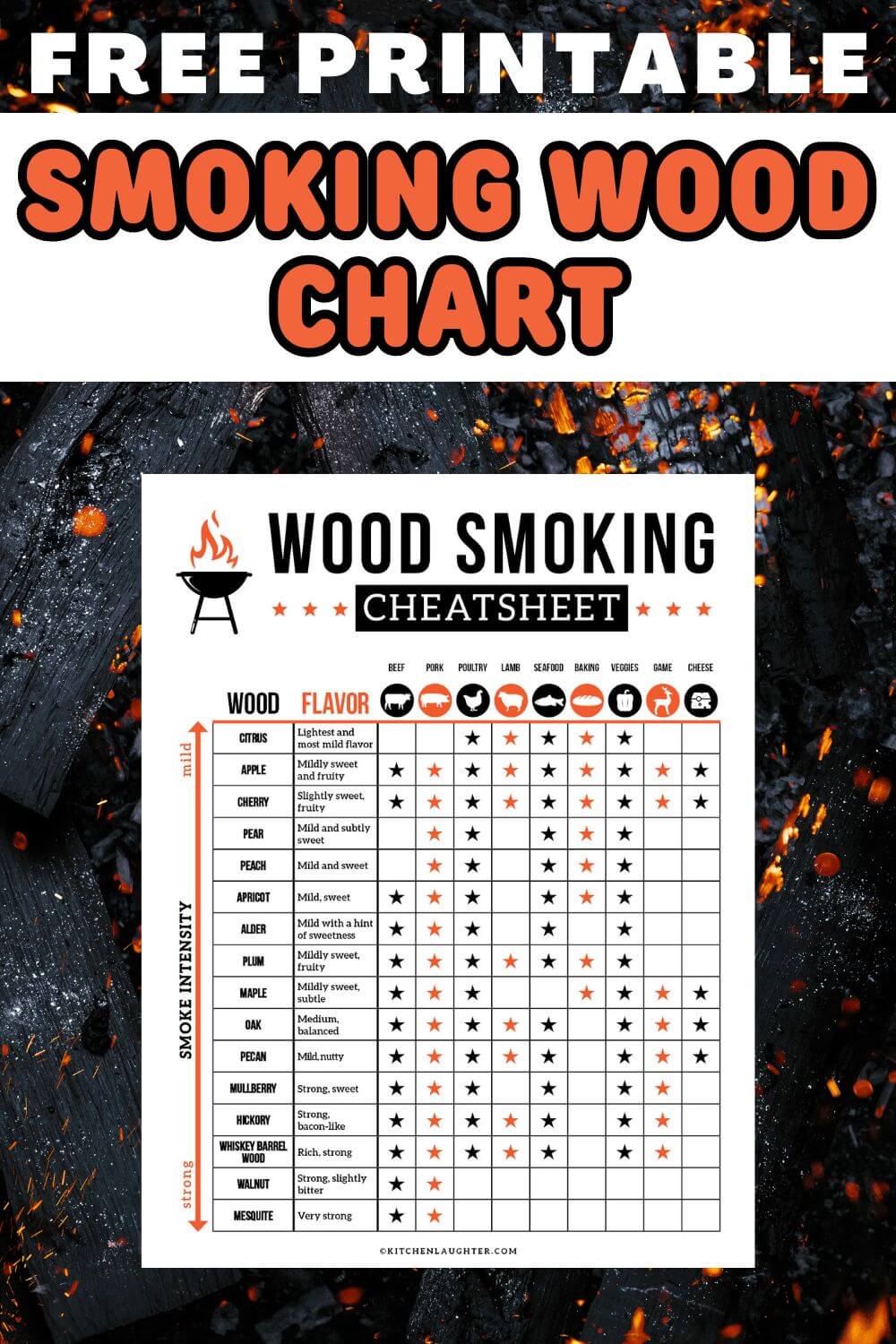


Leave a Reply